Read Aloud Play: Stolen Childhoods--Lewis Hine's Crusade to End Child Labor
- PDF
- Easel Activity
What educators are saying
Description
At the height of the Great Depression, the pioneering photography of Lewis Hine freed generations of children from having to slave away for pennies an hour in coal mines, canneries, and textile mills. Hine often risked physical harm to photograph children in deplorable working conditions, but his work eventually led to the establishment of America’s child labor laws. Originally published in the Oct. 31, 2011, issue of Scope Magazine and republished in the Feb. 27, 2012, issue of Junior Scholastic, this powerful play is suited for students in grade 4 though 8 and includes parts for from nine to sixteen actors (and innumerable extras) depending on your casting needs. Includes comprehension activity, teacher notes, and extensions. Consider pairing it with my script, The Newsies, from the same era. Visit my podcasts page at ReadAloudPlays.com to watch a YouTube multimedia presentation of Stolen Childhoods featuring Hine’s original pictures along with a 5th grade audio performance. Thanks!






